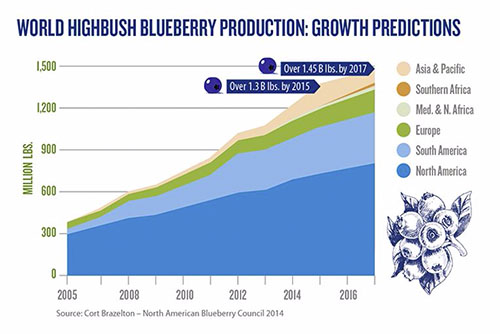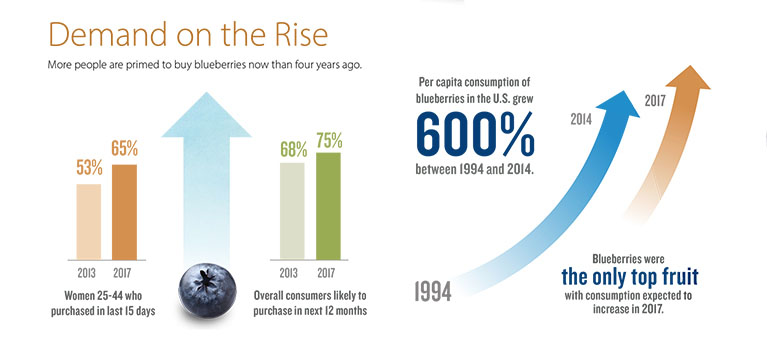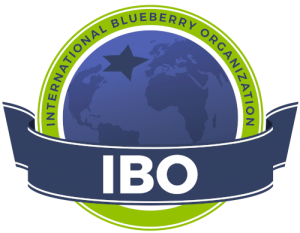 Blueberries are a staple for many consumers, but where are the opportunities to grow the category and turn casual consumers into berry enthusiasts? That’s a question that the U.S. HighbushBlueberry Council (USHBC) is addressing, and they are doing so through a number of programs guided by consumer research that reveals the potential path and the promise of growing the blueberry market.
Blueberries are a staple for many consumers, but where are the opportunities to grow the category and turn casual consumers into berry enthusiasts? That’s a question that the U.S. HighbushBlueberry Council (USHBC) is addressing, and they are doing so through a number of programs guided by consumer research that reveals the potential path and the promise of growing the blueberry market.
I recently had the opportunity to talk with Mark Villata, Executive Director of the Blueberry Council, to learn more about the Council’s marketing programs, findings and the opportunities inherent in the category.
“We’ve had some real positive things come out of this recent opportunity—this assessment research that we have conducted—and we’ve found that our target audience is changing. We have broken things down into heavy users, moderate users, and light users—and found we have a lot of potential with the moderate users,” Mark told me, noting that while to heavy users—largely parents 25 to 45—blueberries are a staple, moderate users enjoy blueberries but have yet to embrace them fully as a part of their lifestyle.
While 65 percent of women 25-44 years of age have purchased blueberries in the last 15 days, according to the Council’s research, many outside that demographic have warming feelings to blueberries too, but haven’t really committed, and it’s these moderate users, Mark noted, that have the largest upside as potentialblueberry enthusiasts.
“These are people [moderate users] who are consuming about six to 18 cups per year. They’re aware of blueberries; they’re interested in blueberries. They just haven’t quite made it part of their lifestyle yet,” Mark said. “And moderate users are a wide range of different ages, ethnicities, and personalities, so we have kind of a wide approach to get our message out to those men and women of all different ages.”
Throughout this winter, the Blueberry Council is keeping consumers primed for purchase through ongoing media relations outreach, as well as social media activities and influencer partnerships emphasizing blueberries’ year-round availability, and showcasing everyday seasonal uses. Winter promotions will continue into 2018 when the Blueberry Council launches a brand new,nationwide digital advertising campaign in January.
The ad campaign, centered around the new Positively Bluetiful creative platform, will run all year round and target moderate blueberry users. On average, these shoppers consume 7.6 cups of fresh blueberries per year and have the greatest potential for increased consumption.
 Mark also noted that, while strong blueberry brands are actively getting blueberries in front of shoppers in retail settings, foodservice presents different challenges and different avenues for growing the blueberry category.
Mark also noted that, while strong blueberry brands are actively getting blueberries in front of shoppers in retail settings, foodservice presents different challenges and different avenues for growing the blueberry category.
“Foodservice is very important to us,” noted Mark. “We’re seeing more and more growth in foodservice. We have a lot of programs to encourage foodservice use. Our research is showing that consumers think a menu item is healthier and more appealing when it includes blueberries, and we’re trying to get that message out to foodservice. And consumers are even willing to pay a little bit more for a menu item that contains blueberries; that’s the type of information that we want to give to foodservice.”
Additionally, the Council is working to increase awareness of the versatility of blueberries.
“Everyone thinks of blueberries as a summer food—in a muffin or a pancake—but we want to educate both consumers and foodservice; you can use blueberries all year-round. Fresh product is available all year round now that imports are coming in from South America. And there are a wide range of ways that you can use blueberries. We’re using blueberries more and more in savory dishes, sauces, meat dishes, and beverages—so we’re trying to break the mold of blueberries going straight to your pancake.”
With fresh product coming in from South America in the off season, said Mark, seasonal constraints have virtually been eliminated for the blueberry category, and exciting new menu possibilities have opened up throughout the year.
Mark also noted that the USHBC’s efforts are not strictly limited to consumer education, retail, and foodservice programs. The company has also undertaken a number of initiatives targeting food manufacturers—most recently introducing a “Made with Real Blueberries” seal campaign, encouraging manufacturers to place theCouncil’s seal on their products and take advantage of consumers’ positive feelings toward blueberries.
“We just launched our Made with Real Blueberries seal campaign last year to gain more awareness and help food manufacturers leverage the whole blueberry health halo that’s out there,” Mark said. “And we’ve had quite a few companies interested in taking advantage of this—a lot of companies overseas, as a matter fact—that are very interested. We think it’s going to be a very good campaign encouraging manufactures to use real blueberries and prompting folks using artificial blueberries to switch over to the real deal.”
Mark added that, in addition to its domestic focus on building up the blueberry category, the BlueberryCouncil is also active in the export market. The organization is currently involved in increasing exports to key markets including Japan, South Korea, and Taiwan, and addressing new markets of opportunity in India, China, Vietnam, and the Philippines.

